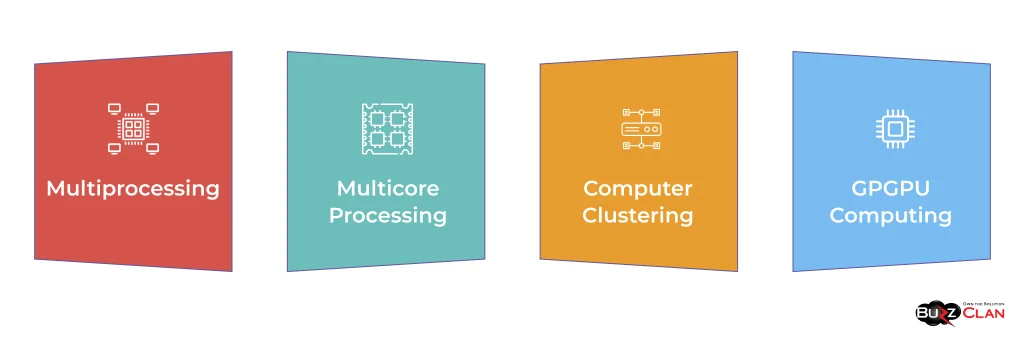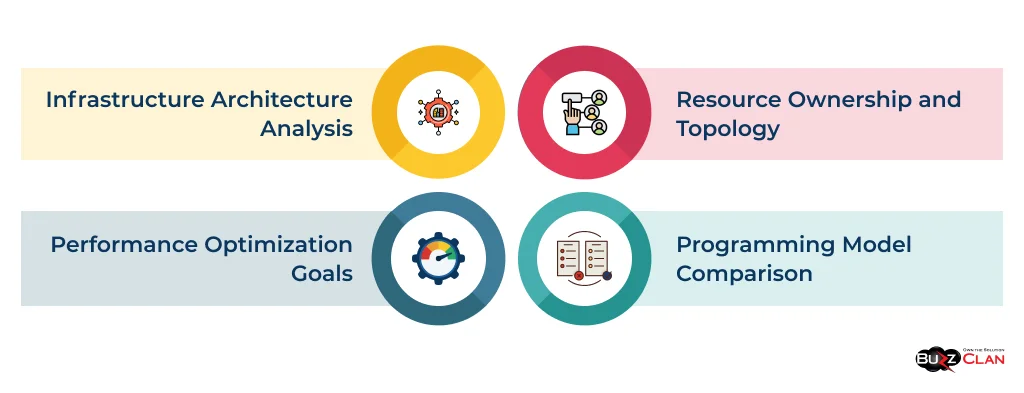Parallel vs Distributed Computing: Key Differences Explained
Harash Jindal
Jun 25, 2024
Introduction
Optimized high-performance computing becomes pivotal as the complexity of computational workloads and data volume explodes. Two crucial strategies gaining momentum encompass parallel computing and distributed computing methodologies.
While related to leveraging clusters for harnessing greater cumulative compute capacities, parallel and distributed paradigms differ architecturally in how tightly or loosely networked the underlying system topology is along dimensions of component proximity, interconnect protocols, and execution coordination models affecting scalability trajectories.
This guide will clarify the contrasts between parallel vs distributed analysis – traversing definitions, reference architectures, performance objectives, real-world use cases, and limitations balanced across infrastructure coupling and orchestration complexity tradeoffs.
By the end, the complementary strengths and synergy opportunities will be evident, assisting adoption choices based on workload profiles and deployment environments. Let’s dive in!
Understanding Parallel Computing
Parallel computing simultaneously executes program subcomponents across multiple processors to accelerate overall workload throughput. It maximizes computational velocity by dividing intensive tasks into fragmented parts processed concurrently.
Parallel execution contrasts with sequential computing, where program instructions run linearly on single compute units completely before the next steps start. Decomposing larger goals into smaller fragments that leverage available CPUs in parallel maximizes speed.
Types of Parallel Computing Approaches

Parallel computing techniques have revolutionized computational capabilities, optimizing the execution of complex tasks by distributing workloads across multiple processing units. Here are some prevalent parallel computing approaches:
Multiprocessing
- Multiprocessing involves utilizing multiple physical processor packages within a single system.
- These processors share underlying memory resources without relying on networking.
- Cloud virtual machines extensively leverage this approach behind the scenes.
Multicore Processing
- Multicore processing takes advantage of centralized chips integrating multiple execution units called cores.
- These cores can be utilized concurrently through software threads that schedule subprocesses optimally, eliminating the need for manual developer intervention.
Computer Clustering
- Computer clustering interconnects standalone machines over high-speed interconnects like Infiniband.
- This approach offers pooled computational capacities by distributing parallel workload shards programmatically and transparently across networked commodity systems.
- Hadoop ecosystems heavily utilize computer clustering.
GPGPU Computing (General-Purpose Computing on Graphics Processing Units)
- GPGPU computing significantly accelerates certain numeric-intensive calculations by employing massive parallel graphical processing units (GPUs) as accelerators.
- It is commonly used for tasks such as machine learning model training, scientific simulations, and media rendering, offloading suitable parts optimally.
Each parallel computing approach offers unique advantages and is suited for specific computational scenarios. Multiprocessing is ideal for tightly coupled tasks requiring low latency communication, while multicore processing is suitable for applications that can be divided into independent threads. Computer clustering excels at handling large-scale distributed workloads, and GPGPU computing is optimized for highly parallel, data-intensive computations.
The choice of parallel computing approach depends on factors such as the nature of the problem, data size, computational requirements, and desired performance outcomes. By leveraging the appropriate parallel computing approach, organizations can harness the combined power of multiple processing units, significantly reducing computation time and enhancing overall system performance.
Fundamentals of Distributed Computing
Distributed computing evolved by tackling exponentially increasing dataset sizes, analytical complexity, and real-time processing needs exceeding traditional centralized systems’ capacities. It refers to an aggregated yet decentralized computational model whereby workload components get spread across multiple computers linked over standard networking interfaces and coordinated through messaging to achieve common goals.
This distributed approach collectively facilitates greater cumulative computing power, storage, and specialized abilities than are available monolithically, conferring immense scaling, efficiency, and fault tolerance advantages. The global internet infrastructure represents an immense grid of interconnected decentralized machines powering modern web services.
The transition from Mainframes to Distributed Architecture
Historically, mainframes and supercomputers sufficed for most analytical workloads executed sequentially using centralized dedicated resources. However, ballooning complexity shattered assumptions as distributed methodologies proved far more adept at tackling immense scales, benefiting from concurrency, parallelization opportunities, and incremental cluster expansion.
Distributed computing emerged by applying fundamental software architecture advancements around loose coupling, high cohesion, and stateless service-oriented principles, hardening resilience and scalability simultaneously while keeping costs lower through leveraging commodity infrastructure abundantly.
Evolution of Cloud Computing Via Distribution
Modern cloud computing intrinsically builds on distributed systems principles for web-scale by allocating on-demand pools of virtualized commodity infrastructure storage and specialized accelerators accessible instantly via APIs, allowing supply to scale dynamically against demand patterns globally, minimizing resource overprovisioning waste through automation and orchestration.
Leading cloud providers, including AWS, Microsoft Azure, Google Cloud Platform, and Alibaba Cloud, run their reliable services, leveraging hundreds of thousands to millions of servers operated in tandem across geo-distributed data centers collectively powered by distributed coordination methodologies.
Key Differences Between Parallel and Distributed

Infrastructure Architecture Analysis
Parallel computing architectures utilize shared memory multiprocessing servers, multicore processors, or localized high-performance computing clusters connecting multiple machines over proprietary high throughput low latency interconnects like Infiniband or PCIe leveraging RDMA, NVLINK enabling tight component data sharing minimizes networking overheads during message transfers.
In contrast, distributed systems embrace potentially vast commodity infrastructure pools linking discrete heterogeneous on-premise data centers or public cloud capacity globally over standard TCP networking exhibiting higher latencies and throughput constraints but benefitting from immense resilience and redundancy capacities despite disruptions.
Resource Ownership and Topology
Parallel frameworks operate on dedicated, preallocated hardware controlled centrally, allowing workload optimization assuming static capacity contours and backplane reliability. This facilitates emphasizing pure computational throughput as a key priority.
Meanwhile, distributed computing jobs opportunistically harness transient nodes contributed voluntarily in shared capacity environments without ownership assumptions, necessitating intelligent scheduling, fault tolerance wiring, and state management objectively across disparate domains with fluctuating supply availability needing arbitration.
Performance Optimization Goals
Parallel computing sharpens workload acceleration on owned hardware, minimizing communication delays between processors or GPU cores, essentially “single point of failure” assumptions, by relying on reliable backplanes dedicated solely to maximizing execution speed linearly.
Conversely, distributed systems target holistic progress across fragmented, decentralized contributions, allowing independent failures by concentrating on efficient coordination, resilient orchestration, and stability, upholding continuity of net value accretion using redundancies to offset volatility from loose coupling.
Programming Model Comparison
Parallel programming leverages shared memory abstractions like OpenMP, threads, and MPI primitives explicitly managing state migrations between processors manually or via schedulers, emphasizing workload partitioning minimizes coordination complexity from tight proximity coupling and backplane speeds.
Distributed applications harness independent asynchronous message-passing protocols like AMQP that transmit events across decentralized, stateless services reliably using enterprise Integration patterns to uphold transactional continuity and Idempotency through retries and safeguards with confirmations despite remote volatility.
Real-World Applications and Use Cases
| Applications | Use Cases |
|---|---|
| High-Performance Computing | Parallel configurations accelerate scientific workloads around genomics sequencing, molecular simulations, weather forecasting, fluid dynamics, and mechanical engineering by assigning fragmented across specialized cluster arrays containing purpose-built servers like GPU/TPU hardware tuned to maximize floating point operations suiting math-intensive modeling. |
| Web Services and XaaS | Distributed platforms dominate delivery chains powering modern cloud services from IaaS, PaaS, and SaaS categories leveraging geo-distributed infrastructure hardening resilience, locality response times, and jurisdictional compliance simultaneously catering massive usage spikes through load balancing algorithms dynamically assigning traffic balancing optimization constraints perpetually. |
Implementation Considerations
Adoption Assessment
When evaluating parallelization and distribution pathways for assorted analytical and delivery workloads, factoring current or planned capabilities incrementally – analyzing expected scaling trajectories, infrastructure budget ceilings, and security governance sensitivities assist in determining ideal balances between performance objectives fueled by optimism versus practically sustaining continuity through prudent redundancy preparations.
Common Complexities Tackling
Substantial integration and operationalization complexities surface needing mitigation upholding system coherence at scale, including:
- Asynchronous processes synchronization imposing state integrity risks from race conditions
- Networking latency delays impacting real-time coordination across remote nodes
- Cybersecurity attack surfaces require access controls across fragmented ecosystems.
- Specialized skill shortages managing massively scaled architectures.
Careful instrumentation, compartmentalization, and automated policy enforcement help smoothen multidimensional complexities, upholding stability, trust, and visibility uniformly across hybrid technology domains, powering software capabilities, and supporting business outcomes.
In closing, parallel computing sharpens workload throughput, locally leveraging dedicated hardware abundance and minimal coordination assumptions. At the same time, distributed methodologies target cumulative value accretion, harnessing decentralized resources collectively despite disruptions and offering reliable capabilities that exceed standalone potential.
Which computational models guide your current analytics, delivery, and modernization initiatives? How do teams balance optimizing speed against resilience while upholding security standards mandatorily? Please share experiences tackling scale challenges productively!
FAQs

Get In Touch
Follow Us

Get In Touch











